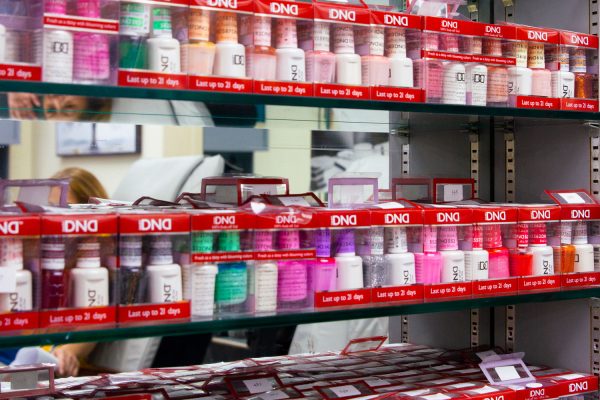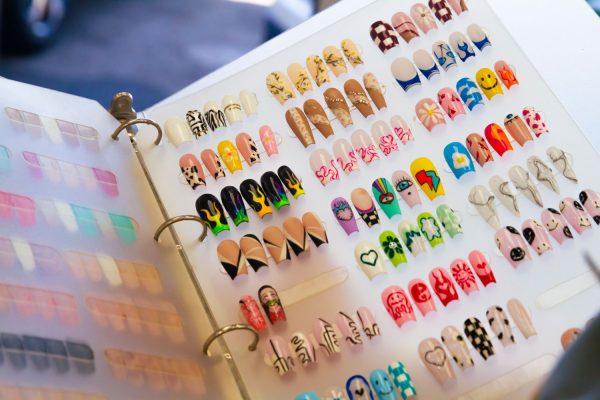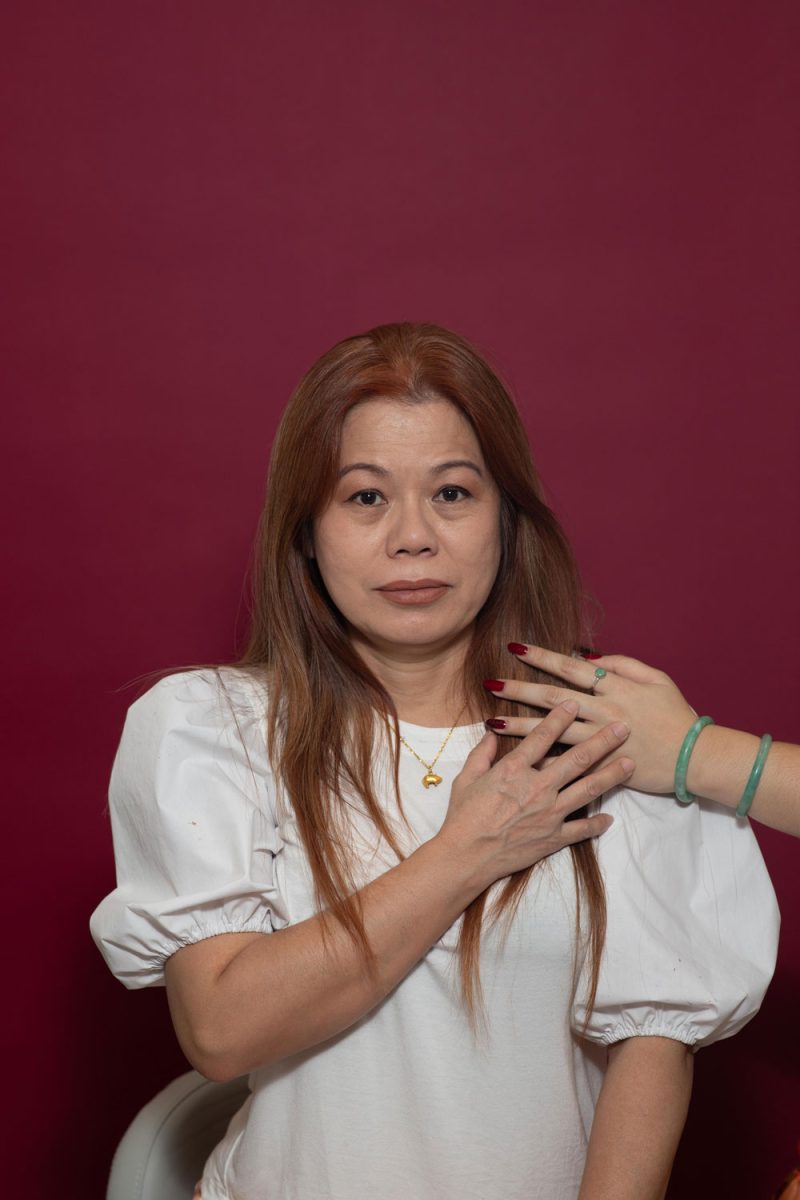From September through December, Ly—a manicurist with over 40 years of experience—packs her toothbrush, socks and undergarments to stay in her cousin’s spare room in West Virginia. Each day, she’s up at 8 a.m. and doesn’t get home until 9 p.m., with just enough time to eat and wash up before starting over. For 11 hours a day, she’s hunched over hands and feet, filing nails, massaging calves, painting designs and helping people feel beautiful. “Even though I used to work in California, I had to move to another state to make enough for both of my kids’ education,” she says.
During other months of the year, Ly is back home in Corona, cooking, cleaning and taking care of her kids who are 17 and 19 years old. She used to be able to support them working part-time at Bamboo Nails, a salon in Yorba Linda. But since wages have failed to keep up, she travels to her cousin’s salon in West Virginia to help manage it, get full-time hours and better tips.
According to The Bureau of Labor Statistics, nail salons in California are predominately staffed by Vietnamese and Vietnamese American professionals. For many, the nail salon is more than a workplace—it’s a space to express their artistry and build community with coworkers and clients. Over the past decade, California’s nail salon workforce has nearly tripled, and the number of salons has nearly doubled, forming part of an $8 billion global industry. Despite its impressive monetary worth, nail technicians like Ly are grappling with unprecedented financial strain, especially after COVID-19. Five years after the pandemic forced extended closures, the industry has yet to fully recover, leaving workers and owners struggling with rising rent, stagnant wages and a declining clientele. Now, many manicurists are left wondering how much longer they can sustain their careers—and their lives—as they face long hours, health concerns and wages that often fall below minimum wage in an industry that often undervalues their skills while demanding relentless effort.
Nail Salons and the Immigrant Story
According to a March 2024 report from the University of California, Los Angeles’ Labor Center, 82% of California’s manicurists are born in Vietnam. This trend dates back to 1975, when the Vietnam War ended, and Vietnamese immigrants were first introduced to the profession. Following the devastation of the 20-year war, hundreds of thousands of Vietnamese refugees arrived in the U.S., and by 2000, nearly a million Vietnamese immigrants had settled in the country. Many women in the diaspora turned to the nail industry for both employment and a sense of community in their new home.
Lucero Herrera, a researcher at UCLA’s Labor Center, says the industry was a way for Vietnamese refugees to gain skills and be able to work right away without higher education or English language skills that other jobs require. In Hope Village, California’s first nonmilitary refugee camp, established in Weimar, California, in June 1975, 20 Vietnamese women laid the foundation for what would become an $8 billion industry.

Ly was born in Saigon, Vietnam, in the late 1960s, several years before the Vietnam War ended. She asked to be identified by a pseudonym to protect her privacy. The youngest of seven children, Ly grew up learning how to cook and clean like many other Vietnamese girls. By the early ‘90s, she immigrated to the U.S. with a decade of experience in manicuring, confident that her skills would help her find a position in a Vietnamese-owned nail salon in America as a temporary means of earning income. However, Ly never transitioned out of the nail profession since doing nails was the only job that fit her schedule as a mother. “When my kids were young, and my husband was unemployed, I applied for jobs in the medical field, but the hours didn’t work out, and the pay wasn’t enough,” she says. “So, I had to return to doing nails because only this job could cover all the expenses for my two kids.”
Today, the profession remains a foundation for immigrants starting new lives in the U.S. Vân Đặng, a civic engagement organizer with the California Healthy Nail Salon Collaborative, began her nail career in 2020 after immigrating to California. Doing nails offered Đặng both a livelihood and the freedom to live openly as a part of the LGBTQ+ community with her wife and two daughters. “I needed money. I needed a job when I first immigrated, and nail job was a profession I could learn quickly and get a license quickly to work,” she says.
The Misclassification of Nail Salon Workers
While the nail industry provides new immigrants with work, manicurists often face significant labor challenges, such as low wages, long hours, limited breaks and tip docking. In 2021, California’s minimum wage was $13 an hour, but in the same year, nail salon workers earned an average of $10.94 an hour. Additionally, the UCLA study found that 65% of workers were rent-burdened, and 19% lived in overcrowded households.
With inflation driving up rent and other costs, some salon owners, require their manicurists to help cover supply expenses. “Nail salon workers get paid what they’re due, but they don’t know that they’re actually giving owners cash back,” says Dung Nguyễn, the organizing manager for the California Healthy Nail Salon Collaborative. After COVID-19, some manicurists who previously earned 60% of service fees and tips now retain only 50%.

Despite issues of wage theft, many manicurists feel they must stay in the profession despite these challenges due to connections in the business and a fear they won’t find another job due to language and education barriers. What makes it even trickier is that 97% of salon owners are also Vietnamese, and 60% are women which often blurs the traditional boundaries of boss and employee, as many employees are related to their coworkers or boss. In the tight-knit Vietnamese community, workers rarely have no personal connection with their workplace. For some manicurists, like Ly, the idea of starting over in a new profession feels impossible. “Doctors advised me to retire, but I won’t have enough money to send the kids to school,” says Ly, who works 50 hours a week with few breaks.
However, the biggest problem in the industry is the misclassification of nail workers. In 2019, Assembly Bill 5 mandated companies hiring independent contractors reclassify them as employees. However, Proposition 22 overturned the bill in 2020, leaving many nail salon workers still classified as independent contractors, which means they get no overtime, paid breaks and other workplace benefits. “We find from our data that almost a third of nail salon workers are classified as self-employed. But we think this is misclassification because when we look at the rest of California workers, [the rate that nail workers are misclassified] is three times higher [compared to other industries],” Herrera says.
Even when workers are correctly classified as employees, Dung Nguyễn says some are still treated as independent contractors. She calls for systemic change to ensure workers can provide for their family in a mentally and physically safe environment.
To some, the income from doing nails is not enough to justify risking their health each day they go to work. After five years in the industry, Đặng was forced to choose between doing nails and her health. “I felt that the toxic chemicals in nail products were not good for my skin and my respiratory system. For me, I needed money to pay for my living expenses, but I love my health more,” says Đặng.
Health Risks Faced by Manicurists
Beyond the bold polishes and sculpted acrylics, nail technicians are exposed to harmful chemicals daily, sometimes for up to 10 hours. UCLA research links prolonged exposure to these chemicals to respiratory issues, skin reactions and cancer.
Dung Nguyễn has seen the negative health effects firsthand. She says workers face a myriad of ailments like allergies, watery eyes, carpal tunnel, contact dermatitis and even reproductive issues. “We have a member [of CHNSC] whose child developed a skin condition like eczema, and she feels it’s because she worked while pregnant with him,” Dung Nguyễn says.
Despite health risks, a 2023 survey conducted by CHNSC reported that 65% of workers lack paid sick leave or family care leave. “After over 40 years in the business, my hands hurt a lot because I use them constantly. I’ve even had hand surgery,” says Ly, who only took one week off work after her surgery, despite her doctor’s order for a three-week-long recovery. She also suffers from chronic sinusitis after decades of inhaling acetone and acrylic dust.

In recent years, progress has been made to reduce the toxicity of cosmetic products. Recent state bills ban the “toxic trio,” of dibutyl phthalate, toluene and formaldehyde, which were the leading causes of health issues in the industry. Dung Nguyễn says the difference in products, proper ventilation and use of personal protective equipment have made the industry a healthier workplace. However, some manufacturers replaced the toxic trio with substitutes like triphenyl phosphate, a chemical that produces similar health risks as dibutyl phthalate.
The industry also needs more education on labor laws for both workers and owners—in a language they can easily understand. For owners, more incentives and support should be available, such as access to small business loans and additional resources that they can use to invest in their workforce and salons. Herrera says that professionalization in the industry can lead to higher wages and career ladders, for many manicurists whose sophisticated skills are often unacknowledged.
The Nail Salon Industry Post COVID-19
California’s strict COVID-19 precautions in 2020 and 2021 included mandated quarantines, closures and business restrictions, which directly impacted nail salons. Five years later, the nail industry is still recovering. Dung Nguyễn believes that the rollercoaster of closing and reopening during the pandemic had an irreparable impact. “Folks are seeing that they’re making about 50% of what they did before. And [some] nail salons still had to pay their commercial rent even though they were closed. So, they’re in a lot of debt, and some feel like it’s something they can’t get out of,” she says.
Manicurist and former nail salon owner Polly Nguyễn says that after COVID-19, she has seen fewer customers in the padded chairs of First Impression Salon, a nail salon in Los Alamitos. In 1990, fifteen years after the fall of Saigon, Polly Nguyễn immigrated to the U.S. through the Humanitarian Operation program that helped former Vietnamese reeducation camp detainees immigrate. Although she was previously a tailor in Vietnam, she turned to doing nails—a service with a higher demand—after immigrating to California. After working in the industry for five years, she became the owner of Eros Nail and Spa in Beverly Hills. But in 2005, due to an increase in competition, a location change, combined with a divorce, Polly Nguyễn decided to close the salon, and moved to Orange County in hopes that the Vietnamese community there would help her find more work.
Over the next 15 years, she bounced around salons in Redondo Beach, Anaheim and Whittier, finally settling down at First Impression Salon in 2021. Then the pandemic hit, and Polly Nguyễn was out of work for months just after joining the team. Now, she works at First Impression Salon and another salon in Orange County to make ends meet and support her four children. “After [COVID-19], the economy has changed a lot, and it is also difficult to get new customers,” says Polly Nguyễn.
When the pandemic forced customers to stay home, some began opting to do their own manicures using press-on nails or DIY nail kits. As inflation and living expenses have increased, many former clients now view manicures as a luxury. A consumer survey found that 41% of respondents visited nail salons once every two to three months after the pandemic. Less than one-quarter went more than once a month.
Consumers weren’t the only ones leaving the nail industry. According to the UCLA study, after the COVID-19 pandemic, nail salon employment levels dropped across the state, from over 32,000 workers in 2020 to around 23,000 in 2021. Faced with new worries about their health, some manicurists retired or changed jobs after the pandemic.
What’s the best way to support salon workers?
For those who still depend on salons to get their nails done, recognizing the person at the other end of their spa chair is essential.

Đặng encourages customers to tip the worker directly via cash, Venmo or Zelle to ensure the whole tip goes to their manicurist. Additionally, Herrera says customers should invest their money in businesses committed to protecting workers’ rights. “As consumers, we’re always trying to find the cheapest option available without taking into consideration what the workers are actually taking home as their pay,” she says. Many salons hesitate to increase their prices in fear of losing clients. However, according to the UCLA study, consumers are willing to pay up to $10 more for better labor conditions.
Direct tips to manicurists help support the extensive skills each manicurist possesses. “A misconception is that nail art does not require high skills, but in reality, this profession requires dexterity, creativity and knowledge of nail care techniques,” says Đặng.
Ly’s daughter, Thí remembers having the best nails at her school events when she was a teenager. Thí also asked to use a pseudonym for her privacy. She now lives in the dorms at the University of California, Santa Barbara, and her nails are often bare these days. But she has fond memories of the indigo gel nails she wore for her senior year homecoming dance and a red set she wore for her senior prom—all crafted by Ly. But it all came with a steep price. “She pretty much worked from like 8 a.m. to 8 p.m. for most days,” says Thí. “My brother and I grew up going to a lot of daycares and having a lot of babysitters and stuff. We didn’t see our parents very often.” When Ly returns to Orange County after her time in West Virginia, her family celebrates by enjoying her homemade Vietnamese dishes like Bún Bò Huế and Phở . She cleans the home, which she shares with her husband and son. “We all feel happier, and our moods are all better, especially my dad who smiles more when she’s home,” says Thí.
In the months Ly is away, Thí spends her time in Santa Barbara missing her mother’s affections like the hand delivered plates of cut fruit brought to her while studying. But what she misses most is Ly herself. “She’s a pretty comforting presence for me,” Thí says. Although she feels guilty about the years of hard work her mom invested in supporting her and her brother’s upbringing, being able to attend UCSB to pursue her passion makes all of Ly’s sacrifices worth it. “We wouldn’t be where we are, or able to do what we want to do, if it weren’t for our parents,” says Thí.
Taken from the Winter 2024 print issue of Inside Fullerton. Read it here.



